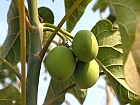|
Picture source: Winrockindia
The jatropha plant has begun its triumphal march through the tropical regions of the earth. A member of the spurge family, its supporters claim that it can supply clean biofuel without the disadvantages suffered by current “energy plants”.
In contrast to rape seed (canola), maize, palm oil or cane sugar, the jatropha nut (commonly known as the physic nut) is not edible – in fact it is poisonous. This means that using jatropha sidesteps the “food or fuel” dilemma which has given the use of other biofuels a bad name. Not only that, the plant grows prolifically where no other weed can survive, and can manage on as little as 300 mm of rain annually. It prospers on fallow or waste land, and therefore does not compete for land which could be used for growing food crops.
At the same time, the jatropha nut contains one of the highest quality vegetable oils that ever ended up in a fuel tank. Further processing of the raw oil is not absolutely necessary, and engines need only minor adjustment to be able to use it. In view of these advantages, the jatropha plant is enjoying a regular boom.
Lighting for an Indian village
Scientists from Empa’s Technology and Society Laboratory are investigating whether jatropha can really fulfill these expectations. Simon Gmuender has been closely examining several jatropha projects in India as part of his obligatory community service. In one such project, an attempt is being made to supply out-of-the-way villages with electricity produced by small-scale power generators. Gmuender’s life cycle assessment of this case gives the plant excellent marks. Another project is dealing with the question of whether large scale, intensive cultivation of the plant is worth the effort. In this case, however, there are still open questions from an ecological point of view.
Since April 2007 the households and streets of the village of Ranidehra, a remote settlement in the Indian state of Chhattisgarh, have been lit with electrical lighting. Three generators hum away in the brand new village power station. To provide fuel to power them, 25,000 jatropha seedlings were planted along the edges of fields and the borders of paths. A filter press extracts the oil from the black seed capsules. Ranidehra now has electricity for four hours per day.
Even jatropha uses up resources
But not even this apparently miraculous plant supplies its oil at zero cost. The seedlings must be transported to far-flung villages, the small power plant needs to be housed in a little building for protection, and a structure needs to be established to administer the new village power network.
On closer examination the physic nut is not quite as undemanding as it might seem at first sight. A certain amount of water and fertilizer are required for the seedlings to grow into fruit-carrying bushes. And although most crop pests avoid the jatropha plant, they do need to be protected from termites, so cultivation is not completely pesticide-free. All these factors need to be taken into account in the life cycle analysis.
The construction of the generator house alone is by necessity associated with some environmental pollution and the usage of land area. Fertilizer and energy were required to breathe life into the village power station.
Despite this the results seem to support those who see the jatropha plant as the solution to our energy problems. Gmuender awards excellent marks to Ranidehra’s nut power station. “Our study shows that using jatropha as a fuel is a far better option than using diesel, or connecting the village to the national power network.” This means that using a diesel generator, fuel for which would need to be transported to the village by tractor, or connection to the electrical mains network would involve much more damage to the environment than using the system fuelled by jatropha nut-oil.
Researchers make suggestions for improvements
The jatropha power station could actually be made significantly better, for in harvesting the seed capsules the villagers make one serious mistake from an ecological point of view. To get to the black capsules the jatropha fruit are heated with steam, produced using a wood fire which in turn released fine particulates into the atmosphere. This wood-fire based process penalizes Ranidehra’s power station significantly in the life cycle analysis. If it could be avoided, then electricity from the jatropha-oil fuelled system would be almost as clean as solar energy.
This is not the case, however, when the plant is cultivated on a large scale. Gmuender, together with his Indian colleagues, is currently drawing up a life cycle evaluation for this situation. Not all the data has been collected yet, but according to Gmuender it appears than in this case jatropha does worse that in the local village power station in Ranidehra.
|

